Cheap Travel Tips for Florence: Tours, transport, where to stay, cheap food and drinks
Florence is one of the top destinations in the world, attracting millions of tourists each year. As is often the case with places that are far from “undiscovered”, the city is not cheap, and in the center some merchants have also learned how to take advantage of unaware tourists. The trick is to get insider information in order to avoid these profiteers and get the best out of Florence.
I have been living in Florence for over a decade, and have traveled a lot around all of Italy. I first came as a study abroad student, and eventually decided to make the move. I’ve seen the city evolve, and I’ve evolved with it, becoming a true local capable of imparting sound, experience-based advice. From not trusting timetables to avoiding anything that’s been translated to another language, what follows is the kind of advice I give my friends when they are planning a trip here.
Getting to Florence on the cheap
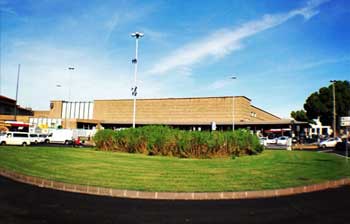
The main train station in Florence is called Santa Maria Novella and it is the only one located in the historical center.
Flights to Florence (or Pisa or Bologna)
If you’re flying into Florence, the local airport (FLR) is connected from most European hubs. Meridiana, an Italian budget airline sometimes has some good deals into this airport. There is a public bus called Vola in Bus that goes from the airport to the train station for €5.
The closest low-cost airport is Pisa, though Bologna is also frequently used. Both are served by Ryan Air and Easy Jet. Local train service is available from both cities to Florence. Pisa airport to Florence costs €9.20 and takes about an hour. It costs €11.50 on the regional train to Bologna, but they have cut down the number of these trains in favour of the fast ones, which however cost twice as much. There is no train at Bologna airport so you also have to take a bus or taxi.
Make sure to check train timetables if you’re connecting to one of these airports because neither have cheap airport hotels, making early morning flights problematic. As Italian rail service is less than reliable, it is helpful to never plan on taking the last train at night, but always the second last, just to be sure.
Getting around Florence
Florence is a small town. You can walk around the whole historical center (within the “ring road” or viali) in a few hours. Most lodging for travelers is found inside this area, which is also served by public busses, except for the quite vast pedestrian part that goes from near the Duomo all the way to the Arno.
Should you be staying further out from the center, the bus system is called ATAF and a one way trip costs €1.20. Tickets must be purchased before boarding and validated using the machines on board. Schedules are posted but rarely respected. Busses at night run infrequently and only until midnight, so if you’re out at night, you may have to take a taxi back.
Taxis are to be avoided as they are very expensive – a short trip around downtown can easily cost €12-15.
Where to stay in Florence on a budget
There are a few hostels in Florence; the newest and best equipped one is Plus Hostel which is about eight minutes’ walk to the train station.
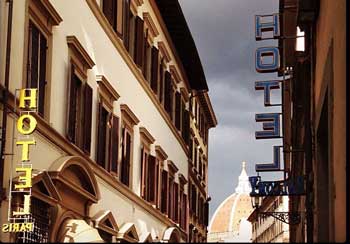
Florence tours
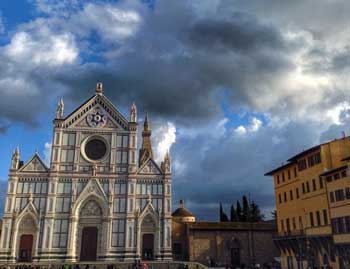
I recommend finding a good itinerary online and creating your own tour. There are lots of good blogs about Florence that have tips you can follow – consider that it takes extra organization to travel on the cheap, but it may also be rewarding. I myself have written a 3 day itinerary to Florence which you can buy on Amazon – plenty of reviewers have found it useful. Similarly, if you’re visiting the Uffizi and don’t want to shell out for a guided tour, look for my IOS app “Uffizi art history guide” which helps you spot the works you really don’t want to miss.
Things to do and see
And speaking of things to see… The major museums in Florence all have entry fees, but the smaller museums and many churches are either free or cost just a few euros, so there’s a lot you can do on a budget. It’s impossible to list them all here, so here are three of my favourites.
Church of Santa Trinità
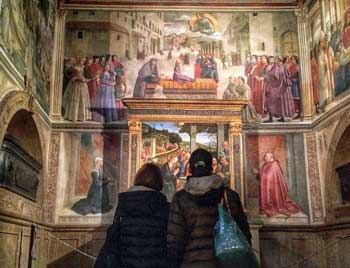
Officina farmaceutica Santa Maria Novella
A historic pharmacy behind the church of the same name, it was started by monks who brewed herbs. The space is gorgeous and it has a display of historic products as well as an entirely frescoed chapel. No purchase is necessary to just go in there, smell and look. (Good thing too – the products are not cheap, though they make a special souvenir.)
Palazzo Davanzati
This early Renaissance house museum costs only €2 to enter. It’s not very big, but it’s very interesting because it is one of the first homes to have an indoor well. The wall paintings are 19th century re-interpretations of the originals, but the structure of the home and the functions of the rooms are authentic.
Others
Beyond churches and museums, the whole city is open to exploration. The area called Oltrarno (meaning other side of the Arno river) is full of artisan workshops and fun cafés. On the opposite side of town, get lost in the curving, narrow streets of the Santa Croce area, which maintains a medieval feel to it.
Free art to see in Florence (museum alternatives)
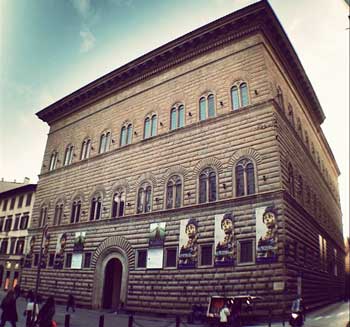
- Strozzina contemporary art space in Palazzo Strozzi is free to enter every Thursday from 6 to 11pm.
- Palazzo Strozzi’s Thursday Squared event in the courtyard every first Thursday of the month provides free activities, and if you buy a drink you get into the exhibit upstairs for free.
- State museums like the Uffizi and Accademia are free or have 2 for 1 entrance fees on certain days: March 8 (free for women), the days around Valentines’ Day (2 for 1), European Heritage Days (every September, free)
- FAI (Fondo Ambiente) springtime event each March opens up usually closed locations for free two days each year – more info (in Italian).
Cheap eats in Florence
I recommend setting aside as much budget as possible for eating. Italy’s cuisine is considered one of the most delicious in the world, and it costs a lot less to eat a great meal in Italy than it does in the UK or USA.
You just have to learn how to avoid the tourist traps, where the food may be mediocre and costly. As a general rule in Florence and in the rest of Italy, I avoid restaurants on the main square, ones that have a printed menu in 4 languages, anything with food displayed in the window, and ones that have a guy handing out a flyer to get you in. These are all signs that the place is geared to tourists.
Finding the best cheap restaurants
To find a good restaurant worth blowing your budget, head down back alleys, look for limited menus with less than a dozen items that are handwritten and only in Italian, and that if you look in at 9:30 or 10pm are packed full of people gesticulating with their hands (i.e. Italians).
In a more scientific manner, follow the guide called Slow Food (only in Italian), and do not follow food advice from any American guidebook. If you’re adventurous, just ask what’s good and eat what they bring you. Chances are you’ll have an experience to write home about.
Even cheaper eating options
For less expensive food, you have a few options. Lunch is easy. Many places that are pricey at dinner have a set lunch menu for €10 to €12 including water and an espresso to kick you back to work. Spot these by the fact that they are full of businessmen at 1:30pm.
Or if you can avoid sitting down in a restaurant, there are many panino (sandwich) joints. If you have a strong stomach, try the very cheap local lampredotto, a bun filled with stewed cow stomach and topped with green sauce from stands in the San Lorenzo and Sant’Ambrogio markets. This is the favourite food of most construction workers.
To sit or stand?
Finally, bear in mind that most bars offer great coffee, sweets and small sandwiches at any time of day for reasonable prices – but that if you sit down, rather than stand at the bar, the price changes.
At aperitivo time (happy hour, but with food) from around 5:30 to 8:30pm, many bars will break out a spread that you access free with the purchase of a drink (and usually you can sit down). Some may cost up to €10 for the drink, but you can make the buffet into a dinner.
Cheap drinking in Florence
The aforementioned aperitivo is the main way that Italians socialize after work or on weekends. It takes place before dinner, but often substitutes dinner entirely. Given the cost of alcohol and the abundance of food, people don’t usually get drunk in these bars.
If you enjoy a good drink and wish to blend in, try a Negroni for your aperitivo – a very strong, bitter drink that was invented in Florence (gin, vermouth and Campari), or the more Venetian spritz (prosecco and Campari). It is culturally acceptable to have 2 drinks here, and totally normal to then down a whole bottle of red wine with dinner (get the jug of house wine to save money).
By Alexandra Korey (Google+)
Alexandra Korey is a Canadian-born art historian who works in arts marketing in Florence Italy. She has been blogging at www.arttrav.com since 2004.
All photos courtesy of Alexandra Korey

this was extremely appreciated
Thank you
Thank you for taking the time to write this. I feel less overwhelmed planning my trip now.